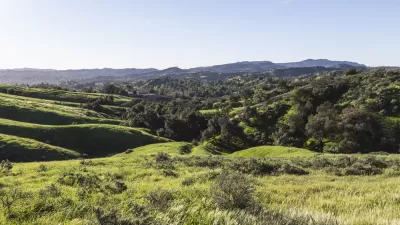Some argue that if something is not directly contributing to our public coffers, why protect it? Perhaps it’s worth broadening our understanding of the services – and tax implications – provided by parks.
A recent Smithsonian retrospective featured records from the 1970s Environmental Protection Agency. One of the more personally interesting ones is from 1972: A woman holding a placard is standing before a strip mall of shops protesting the protection of an ecologically sensitive area. Her placard reads, “We pay taxes; parks don’t”.
According to EPA records, the Ocean Beach businesswoman raising the placard led a fight to reopen a beach that had been closed to auto traffic. The state government had banned cars from a stretch of beach during the summer months to protect clam beds. The woman demonstrated against this by joining with 200 other motorists to drive the two miles over the prohibited section of the beach.
Her statement, of course, is correct. In the most literal sense, parks don’t have agency to pay taxes. Birds don’t pay taxes either, nor do trees. How far should we extend her argument? Her point, however, is understood. If something is not directly contributing to our public coffers – and affecting our liberty – why protect it?
It has been argued that parks make cities less affordable as they limit developable land and therefore disrupt the “law” of supply and demand housing stock: less land supply, less houses = increased value in existing housing stock. This is an awfully narrow interpretation of park space and perhaps it’s worth broadening our understanding of the services – and tax implications – provided by parks.
Parks provide recreation and tourism value in terms of tax revenue and commercial activities. They provide a space for the consumption of goods and services such as picnic areas or concert venues. Property values of adjacent residential and commercial areas can be measured against properties in the same neighbourhood that don’t border a park: a (well cared for) park nearby increases property values.
Parks also provide “ecosystem services” that can be quantified to measure environmental benefits. For example they also provide flood control and mitigation through permeable surfaces allowing the absorption of water. They regulate air quality and temperature by reducing “heat islands” associated with areas covered by asphalt and concrete which tend to create a dome of heat above their surfaces impacting not only human comfort but plant and wildlife tolerance.
A 2004 report by Ducks Unlimited & Nature Conservancy Canada [PDF] showed that protected wetlands regulate water supply and treatment, as well as are a component in food production by providing plants for pollinators.
The mitigation and regulatory services provided by parks has direct financial benefits. Engineered infrastructure costs can be lessened – from concrete storm water systems to the necessity of air conditioning units. A 2011 report by Alberta Environment [PDF] focusing on the southwest edge of Calgary revealed the cost of replacing the storm water services provided by the area’s wetlands with built infrastructure would be $338 million.
Indirect benefits of parks should also to be realized. A 2005 report in the American Journal of Medicine [PDF] indicated that people with ready access to a park were 50% more likely to adhere to a regular walking regime, increasing their mental and physical well-being and thus decreasing health care costs.
Research shows that common spaces with vegetation receive more use and therefore increase opportunities for social interaction among users. This has the potential to advance community cohesion contributing to psychological wellness, again revealing the tacit relationship between parks and health services.
A 2013 article in the American Journal of Preventive Medicine [PDF] indicated that when there is a major change to our natural environment, evidence points to an increase in mortality related to heart and lung illness. The study showed that the widespread removal of an area’s tree canopy led to a psychological impact on residents leading to negative health impacts.
The services provided by parks, from regulatory to cultural, are gaining traction in economic evaluations; parks are being economically quantified to justify their protection. What are the benefits to this approach? What are the drawbacks? My next article will explore this topic.

Maui's Vacation Rental Debate Turns Ugly
Verbal attacks, misinformation campaigns and fistfights plague a high-stakes debate to convert thousands of vacation rentals into long-term housing.

Planetizen Federal Action Tracker
A weekly monitor of how Trump’s orders and actions are impacting planners and planning in America.

San Francisco Suspends Traffic Calming Amidst Record Deaths
Citing “a challenging fiscal landscape,” the city will cease the program on the heels of 42 traffic deaths, including 24 pedestrians.

Defunct Pittsburgh Power Plant to Become Residential Tower
A decommissioned steam heat plant will be redeveloped into almost 100 affordable housing units.

Trump Prompts Restructuring of Transportation Research Board in “Unprecedented Overreach”
The TRB has eliminated more than half of its committees including those focused on climate, equity, and cities.

Amtrak Rolls Out New Orleans to Alabama “Mardi Gras” Train
The new service will operate morning and evening departures between Mobile and New Orleans.
Urban Design for Planners 1: Software Tools
This six-course series explores essential urban design concepts using open source software and equips planners with the tools they need to participate fully in the urban design process.
Planning for Universal Design
Learn the tools for implementing Universal Design in planning regulations.
Heyer Gruel & Associates PA
JM Goldson LLC
Custer County Colorado
City of Camden Redevelopment Agency
City of Astoria
Transportation Research & Education Center (TREC) at Portland State University
Jefferson Parish Government
Camden Redevelopment Agency
City of Claremont






























